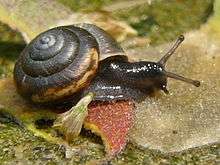Trochulus hispidus
| Trochulus hispidus | |
|---|---|
 | |
| A live individual of Trochulus hispidus (an older adult with most of the hairs worn off of the shell) | |
| | |
| Five views of a shell of Trochulus hispidus | |
| Scientific classification | |
| Kingdom: | Animalia |
| Phylum: | Mollusca |
| Class: | Gastropoda |
| (unranked): | clade Heterobranchia clade Euthyneura clade Panpulmonata clade Eupulmonata clade Stylommatophora informal group Sigmurethra |
| Superfamily: | Helicoidea |
| Family: | Hygromiidae |
| Subfamily: | Hygromiinae |
| Tribe: | Trochulini |
| Genus: | Trochulus |
| Species: | T. hispida |
| Binomial name | |
| Trochulus hispidus (Linnaeus, 1758)[2] | |
| Synonyms | |
|
Trichia hispida | |
Trochulus hispidus, previously known as Trichia hispida, common name, the "hairy snail", is a species of air-breathing land snail, a terrestrial pulmonate gastropod mollusk in the family Hygromiidae, the hairy snails and their allies.
Distribution
This species occurs in a number of European countries and islands including:
Western Europe:
- The British Isles: Great Britain and Ireland
- Netherlands, Belgium, Luxembourg
- Faroe Islands
- France
- Switzerland, Liechtenstein[1]
Northern Europe:
- Denmark, Norway, Sweden, Finland[1]
Central Europe:
- Austria, Germany, Czech Republic, Poland, Slovakia, Hungary, Romania[1]
Southern Europe:
- Andorra, Spain, Italy, Bulgaria[1]
Eastern Europe:
Description
The 3-6 x 5-11 mm shell has 5-6 moderately convex whorls which are rounded or very slightly keeled at the periphery. The aperture has a thin white lip inside. The umbilicus is open and usually wide at 1/8-1/4 of shell diameter. In colour the shell is brown to cream, sometimes with a light band at the periphery. The periostracum is irregularly striated, and densely covered with short (0.2-0.3 mm), curved hairs. These hairs usually remain in the umbilicus if worn away from the rest of the shell. Lost hairs leave pronounced scars.[4]
The animal is brownish grey with a darker anterior part.[4]

Anatomy
This species of snail creates and uses love darts before mating. The love dart of this species is thorn-shaped.
Shepeleva (2014) studied eyes of Trochulus hispidus.[5]
Ecology
The size of the egg is 1.5 mm.[6]
Interestingly, a hairy snail was found in the plumage of a great tit (Parus major) wintering in SW Poland in 2010. This passerine was the smallest bird species reported to carry a gastropod.[7]
References
- 1 2 3 4 5 6 Pall-Gergely B. (2013). "Trochulus hispidus". In: IUCN 2014. IUCN Red List of Threatened Species. Version 2014.1. <www.iucnredlist.org>. Downloaded on 02 July 2014.
- ↑ Linnaeus C. 1758. Systema naturae per regna tria naturæ, secundum classes, ordines, genera, species, cum characteribus, differentiis, synonymis, locis. Tomus I. Editio decima, reformata. pp. [1-4], 1-824. Holmiae. (Salvius).
- ↑ Balashov I. & Gural-Sverlova N. 2012. An annotated checklist of the terrestrial molluscs of Ukraine. Journal of Conchology. 41 (1): 91-109.
- 1 2 "Species summary for Trochulus hispidus". AnimalBase, last modified 4 January 2014, accessed 28 June 2014.
- ↑ (Russian) Shepeleva I. P. (2014). "Сравнительный анализ камерных глаз брюхоногих легочных моллюсков Trochulus hispidus (Linnaeus, 1758) из Южной Швеции и Калининградской области (Stylommatophora, Hygromiidae). A comparative analysis of the camera eyes of gastropod pulmonate mollusk Trochulus hispidus (Linnaeus, 1758) from the South Sweden and Kaliningrad Region (Stylommatophora, Hygromiidae)". Ruthenica 24(2): 123-127 PDF.
- ↑ Heller J.: Life History Strategies. in Barker G. M. (ed.): The biology of terrestrial molluscs. CABI Publishing, Oxon, UK, 2001, ISBN 0-85199-318-4. 1-146, cited page: 428.
- ↑ RUSIECKI S. & RUSIECKA A. 2013. Hairy snail Trochulus hispidus (Linnaeus, 1758) in flight - a note on avian dispersal of snails. Folia Malacologica 21(2):111-112.
Further reading
- Dépraz A., Hausser J. & Pfenninger M. (2009). "A species delimitation approach in the Trochulus sericeus/hispidus complex reveals two cryptic species within a sharp contact zone". BMC Evolutionary Biology 2009(9): 171. doi:10.1186/1471-2148-9-171
- Kruckenhauser L., Duda M., Bartel D., Sattmann H., Harl J., Kirchner S. & Haring E. (2014). "Paraphyly and budding speciation in the hairy snail (Pulmonata, Hygromiidae)". Zoologica Scripta, 43(3): 273-288. doi:10.1111/zsc.12046.
- Proćków M. & Kuźnik-Kowalska E. (2016). "Major fitness components in life history of euryoecious land snail Trochulus hispidus (Linnaeus, 1758)(Gastropoda: Hygromiidae)". Folia Malacologica 24: 179-184. doi:10.12657/folmal.024.015. PDF
External links
| Wikimedia Commons has media related to Trochulus hispidus. |
- "Trichia hispida". National Center for Biotechnology Information (NCBI).
- Trochulus hispidus as Trichia hispida images at Encyclopedia of Life
